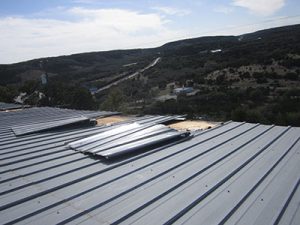Integrating solar panels with commercial roofing is a strategic move that can yield significant benefits, aligning sustainability goals with potential cost savings. Here’s a breakdown of key aspects:
Types of Solar Roofing Integration:
There are primarily two ways to integrate solar technology with commercial roofs:
- Traditional Solar Panels (Photovoltaic – PV Modules): These are the most common type, installed on top of the existing roof using various mounting systems.
- Building-Integrated Photovoltaics (BIPV): This involves integrating solar technology directly into the roofing materials themselves, such as solar shingles or tiles. While aesthetically appealing, BIPV options can sometimes be less efficient and more costly than traditional panels.
Advantages of Integrating Solar Panels with Commercial Roofing:
- Reduced Energy Costs: Generating on-site electricity significantly lowers or even eliminates monthly utility bills.
- Environmental Benefits: Solar energy is a clean, renewable resource, reducing a building’s carbon footprint and reliance on fossil fuels.
- Potential for Increased Property Value: Buildings with solar installations are often more attractive to buyers and can command higher resale values.
- Energy Independence: Reduces dependence on utility companies and provides a hedge against rising electricity costs.
- Tax Incentives and Rebates: Federal, state, and local governments often offer financial incentives for solar installations, improving the return on investment.
- Extended Roof Lifespan (in some cases): Solar panels can act as a protective layer for the roof membrane, shielding it from weather and UV exposure, potentially extending its lifespan.
- Sustainability and Green Building Certifications: Installing solar can contribute to LEED and WELL building certifications, enhancing a company’s reputation for sustainability.
- Potential to Earn Revenue: In some cases, excess energy generated can be sold back to the grid.
- Low Maintenance: Solar panels generally require minimal maintenance, primarily occasional cleaning.
- Quiet Operation: Solar energy systems produce virtually no noise.
Considerations for Integrating Solar Panels with Commercial Roofing:
- Roof Condition and Suitability: A thorough inspection is crucial to ensure the roof is structurally sound, has sufficient space, and is appropriately oriented to maximize sun exposure. The age and condition of the existing roof will influence the viability and cost-effectiveness of solar integration. Replacing an old or damaged roof before installing solar panels is often recommended to avoid the added expense of removing and reinstalling the solar system later.
- Installation Method and Roof Penetration: Attached racking systems involve penetrating the roof membrane, which requires careful waterproofing to prevent leaks and maintain the roof’s warranty. Ballasted systems, which weigh down the panels, avoid penetrations but may have weight limitations and wind uplift concerns.
- Load Capacity: The roof structure must be able to support the additional weight of the solar panels and mounting systems. A structural analysis may be necessary.
- Wiring and Electrical Components: Proper planning and installation of wiring, inverters, and other electrical components are essential for efficient power distribution and safety.
- Maximizing Sun Exposure: The angle and orientation of the solar panels should be optimized to capture the most sunlight throughout the day. Factors like shading from nearby buildings or trees need to be considered.
- Maintenance and Access: A plan for regular maintenance and ensuring safe access to the panels for cleaning and repairs is important.
- Fire Safety: Solar installations must comply with fire codes, ensuring firefighters have adequate access to the roof.
- Warranties: Understanding the warranties for both the solar panels and the roofing system is crucial, especially how the installation might affect the existing roof warranty. Choosing contractors experienced in both roofing and solar installation can help navigate these complexities.
- Cost and Financing: The initial investment for solar roofing can be significant. Exploring financing options like leases, power purchase agreements (PPAs), and available incentives is important.
- Local Regulations and Permitting: Compliance with local zoning laws, building codes, and permitting requirements is necessary.
Integrating solar panels with commercial roofing is a complex project that requires careful planning and the expertise of qualified professionals in both roofing and solar installation. However, the long-term benefits of reduced energy costs and environmental responsibility can make it a worthwhile investment for many commercial property owners. Contact New Heights Roofing today to get your roof solar-ready!






